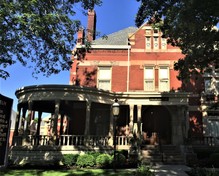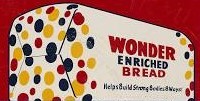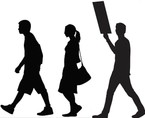
1829   Construction of the National Road entered Indiana at Richmond on the eastern edge of the state.  It would be five years before the road reached the western edge at Terre Haute. Now known as U. S. 40, the thoroughfare played a major role in the development of the state and nation.
|

1865   Robert Lincoln, his mother Mary Todd Lincoln, and his brother Thomas (Tad) Lincoln passed through Lafayette. They were on their way to Oak Ridge Cemetery in Springfield, Illinois, where Abraham Lincoln was to be buried. The body of the fallen President was traveling from Washington on a special funeral train. Pictured: Robert Lincoln
|
 1892   The Executive Committee of the Local Council of Women met for the first time at the Propylaeum in Indianapolis (pictured.) The organization was created to provide a forum for women’s clubs engaged in civic reform. Among the issues were women’s suffrage, public sanitation, and child labor. In 1926, the name of the Local Council was changed to the Indianapolis Council of Women. 1892   The Executive Committee of the Local Council of Women met for the first time at the Propylaeum in Indianapolis (pictured.) The organization was created to provide a forum for women’s clubs engaged in civic reform. Among the issues were women’s suffrage, public sanitation, and child labor. In 1926, the name of the Local Council was changed to the Indianapolis Council of Women. |

100 YEARS AGO
1921   One guard was killed and two inmates injured in an escape attempt at the Jeffersonville Reformatory. Six prisoners, who had recently been denied pardons, killed guard John H. Grimm and broke out of their cells. They waged a 90-minute gun battle with guards and police before surrendering. Much credit was given to Harry Goldman, a trusty who helped foil the escape plan and alerted the guards.
|
 1955   Shoppers in Indianapolis, Muncie, Greensburg, and other cities were enjoying a bread price war. Sliced bread, which had been 21-cents a loaf, was dropped to 15-cents by the Continental Baking Company. Almost immediately, the makers of Colonial Bread, Taystee Bread, and Yum Yum Bread matched the 15-cent charge. The price war was evidently started when Standard Groceries and A&P stores offered their bread at 17-cents. 1955   Shoppers in Indianapolis, Muncie, Greensburg, and other cities were enjoying a bread price war. Sliced bread, which had been 21-cents a loaf, was dropped to 15-cents by the Continental Baking Company. Almost immediately, the makers of Colonial Bread, Taystee Bread, and Yum Yum Bread matched the 15-cent charge. The price war was evidently started when Standard Groceries and A&P stores offered their bread at 17-cents. |

50 YEARS AGO
1971   Thousands of teens across Indiana participated in a “Hunger Walk.” The event, sponsored by the American Freedom from Hunger Foundation, took place in 20 Hoosier cities. Participants in Indianapolis, Fort Wayne, South Bend, Muncie and other cities carried a variety of signs urging fellow citizens to donate to the campaign. One sign said, “Don’t Scrooge Me – Feed Me.” The routes covered large areas of the cities involved. Some teens in Indianapolis walked 27 miles.
|
ABE MARTIN SEZ:
A good listener is usually thinkin’ about somethin’ else.  (Kin Hubbard, The Indianapolis News, June 11, 1924)
Follow this link to subscribe to Hoosier History Highlights and to view archived editions
Follow us on Instagram: @instatehousetouroffice
|





 1892   The Executive Committee of the Local Council of Women met for the first time at the Propylaeum in Indianapolis (pictured.) The organization was created to provide a forum for women’s clubs engaged in civic reform. Among the issues were women’s suffrage, public sanitation, and child labor. In 1926, the name of the Local Council was changed to the Indianapolis Council of Women.
1892   The Executive Committee of the Local Council of Women met for the first time at the Propylaeum in Indianapolis (pictured.) The organization was created to provide a forum for women’s clubs engaged in civic reform. Among the issues were women’s suffrage, public sanitation, and child labor. In 1926, the name of the Local Council was changed to the Indianapolis Council of Women.
 1955   Shoppers in Indianapolis, Muncie, Greensburg, and other cities were enjoying a bread price war. Sliced bread, which had been 21-cents a loaf, was dropped to 15-cents by the Continental Baking Company. Almost immediately, the makers of Colonial Bread, Taystee Bread, and Yum Yum Bread matched the 15-cent charge. The price war was evidently started when Standard Groceries and A&P stores offered their bread at 17-cents.
1955   Shoppers in Indianapolis, Muncie, Greensburg, and other cities were enjoying a bread price war. Sliced bread, which had been 21-cents a loaf, was dropped to 15-cents by the Continental Baking Company. Almost immediately, the makers of Colonial Bread, Taystee Bread, and Yum Yum Bread matched the 15-cent charge. The price war was evidently started when Standard Groceries and A&P stores offered their bread at 17-cents.



